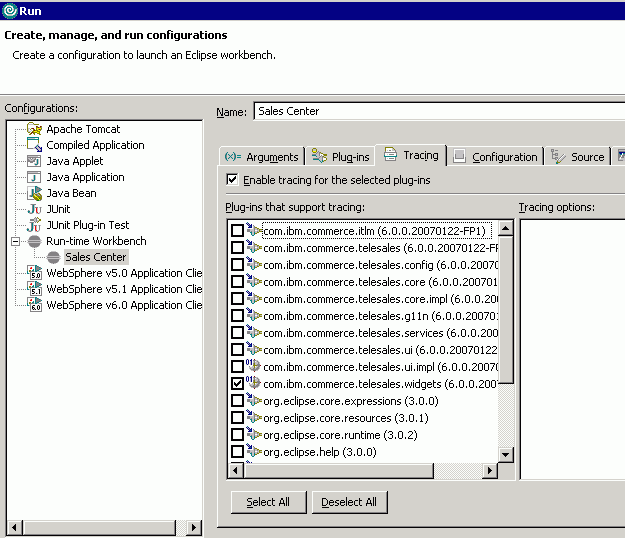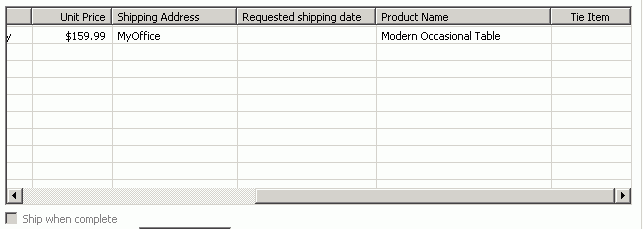Tutorials > Sales Center > Add a column to the order items table
Determine the ID of the user interface widget to modify
In this step we will determine which user interface element of the IBM Sales Center to extend and gather the necessary information about the extension point.
Enable widget hover logging
Procedure
- In the IBM Sales Center development environment, import all of the plug-ins with the name com.ibm.commerce.telesales.ui.impl* into the workspace as binary projects. By importing the projects, you can search for the ID of the user interface element that corresponds to the order items table.
To import the plug-ins:
- Click the Plug-ins view and select all of the plug-ins that begin with com.ibm.commerce.telesales.ui.impl. By default, the Plug-ins view displays in the Plug-in Development perspective on the left side of the window.
- Right-click the selected plug-ins and select Import > As Binary Project. The imported projects display in the Package Explorer view.
- Click the Plug-ins view and select all of the plug-ins that begin with com.ibm.commerce.telesales.ui.impl. By default, the Plug-ins view displays in the Plug-in Development perspective on the left side of the window.
- Enable widget hover logging. When widget hover logging is enabled you can move the mouse pointer over the user interface widget to be modified and its ID will display in the console of the IBM Sales Center development environment. This is an efficient method for locating the widget ID.
- In the IBM Sales Center development environment, from the main menu click Run > Run.
- On the Run dialog, select the Trace tab
- Select Enable tracing for the selected plug-ins.
- In the Plug-ins that support tracing pane select the check box for com.ibm.commerce.telesales.widgets.
- In the right pane ensure that debug, debug/logging and debug/widgetHoverLogging are selected. The screen should appear as shown in the following screen capture:

- Click Run to open the IBM Sales Center client.
- In the IBM Sales Center development environment, from the main menu click Run > Run.
Hover over the user interface widget to modify
In this section, we will move the mouse pointer over the order items table to find its ID.
- To determine the user interface widget that corresponds to the order items table:
- Open the order you created in the Create a customer and an order step.
To open an order, open the IBM Sales Center information center by navigating to the Help menu, clicking Help Contents and searching for the topic "Finding a order".
- Click on the Order Items tab to display the order items table in the editor. Notice that the table headings display as follows, without the Availability Date column:

- Open the order you created in the Create a customer and an order step.
- Notice how the trace changes as the pointer is moved over the user interface. Hover the mouse pointer over the order items table and note the user interface widget names that are displayed in the console view of the IBM Sales Center development environment. The trace indicates that the order items table definition com.ibm.commerce.telesales.ui.impl.orderItemPageItemTable.orderitempage.
Tip: To determine the widget ID be able to view the Console output within the Sales Center plug-in development environment while navigating the Sales Center screens. Therefore you might need to reduce the size of the IBM Sales Center window so that the Console is also visible. It may also be necessary to re-size the Console trace window.
- Close the IBM Sales Center client.
- In the IBM Sales Center development environment, click Search > File.
- In the Containing text field, enter orderItemPageItemTable.orderitempage.
- In the File name patterns field, enter *.xml.
- Click Search.
- In the Search view, two search results display. For the result in com.ibm.commerce.telesales.ui.impl.order, open the fragment.xml file to view the following text:
<control tableDefinitionId="orderItemPageTableDefinition" multi="true" type="table" managerType="salesContainerItemPageManager" modelPath="salescontainer.items"> <property name="tableType" value="orderItemPageItemTable"/> </control> Notes:
- The above text indicates that the id of the control is orderItemPageItemTable.orderitempage, and the definition of the control is a table with the id orderItemPageTableDefinition.
If you search for orderItemPageTableDefinition in this same fragment.xml file, we will find the definition of the table, including definitions for each column in the table. If you look closely, we will find two different definitions for the table, with slightly different names. The orderItemPageTableDefinition.B2B definition is used for B2B-type stores and contains columns required only in B2B scenarios such as contract information. The orderItemPageTableDefinition.default definition is used when the store is not of B2B type. This is the definition we will extend in this tutorial.
- The other search result is in com.ibm.commerce.telesales.ui.impl.return. If you examine the fragment.xml file in that plug-in, we will find that it is just a reference to the definition you already found in com.ibm.commerce.telesales.ui.impl.order.
- The above text indicates that the id of the control is orderItemPageItemTable.orderitempage, and the definition of the control is a table with the id orderItemPageTableDefinition.
If you search for orderItemPageTableDefinition in this same fragment.xml file, we will find the definition of the table, including definitions for each column in the table. If you look closely, we will find two different definitions for the table, with slightly different names. The orderItemPageTableDefinition.B2B definition is used for B2B-type stores and contains columns required only in B2B scenarios such as contract information. The orderItemPageTableDefinition.default definition is used when the store is not of B2B type. This is the definition we will extend in this tutorial.
At this point, you know that the user interface widget to modify is the order items table, and it is defined in the com.ibm.commerce.telesales.ui.impl.order plug-in, with the tableDefinitionId orderItemPageTableDefinition.default.
Disable the previously enabled hover logging
- In the Sales Center plug-in development environment, from the main menu select Run > Run
- In the Run window select the Trace tab and deselect Enable tracing for the selected plug-ins
- Click Apply and then click Close.